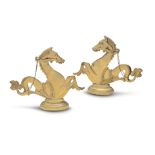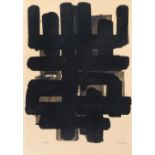16
Attributed Joan Rebull (Spanish, 1899-1981): A sculpted terracotta and plaster half bust figure ...
In Collections
Attributed Joan Rebull (Spanish, 1899-1981): A sculpted terracotta and plaster half bust figure of a young girl probably used in the Théâtre de la Mode (Theatre of Fashion) London touring exhibition, in 'The Roundabout' tableaux as part of the Twelve Scenes, circa 1945-46, the exhibition originally held, Paris, March 25th to May 6th, 1945, The bust with outstretched arms and flowing coiffure, indistinctly signed to the lower edge of the torso to the right hand side, '**bull', 42cm wide, 12cm deep, 32cm high (16 1/2in wide, 4 1/2in deep, 12 1/2in high) ((Sold together with a copy of the original London exhibition catalogue, sponsored by The Daily Mail, under the patronage of The British Ambassador in Paris and Lady Diana Cooper, and the French Ambassador in London and Madame Massigli) (2) Footnotes: Provenance The Collection of Martin Battersby (1914-1982). Thence by descent to Kenneth Partridge (1926-2015). Similar busts by Joan Rebull are illustrated in the 1945 British 'Le Théâtre de la Mode' catalogue (N.B., the catalogue without page numbers). Joan Rebull i Torroja was a Spanish sculptor, considered by some to be one of the most important sculptors of the 20th century in Catalonia. Some of his works are exhibited at the MNAC and the Reina Sofía Museum, as well as at the Museum of Art and History of Reus, which received a donation in 1999 from the artist's widow of 140 works, most of them made of terracotta and plaster. The Théâtre de la Mode (Theatre of Fashion) exhibition of small-scale fashion mannequins, created at approximately a third of the size of human scale and crafted by the leading Parisian fashion designers of the day, was premiered in Paris in spring 1945 and later toured Europe before travelling to the US in a modified form in 1946. When Paris was liberated at the end of World War Two, the idea for a miniature theatre of fashion came from Lucien Lelong, president of Chambre Syndicale in conjunction with L'Entraide Francasie (French National Relief) and Robert Ricci, son of designer Nina Ricci. Its purpose was to raise funds for war survivors and to help revive the French fashion industry in the aftermath of the atrocities which had decimated the city, whilst also showcasing the work of numerous Parisian couturiers. As the materials required to produced full size mannequins and fashions were in very short supply and staging 'real life' fashion shows was near impossible, Ricci proposed using miniature doll-like models to address the need to conserve valuable resources which measured approximately 27.5in (700mm) tall and were fabricated from wire. As such when the Chambre Syndicale decided to embark on this concept, this harked back to the old practice of sending dolls dressed in miniature versions of outfits to faraway buyers. Apart from Lucien Lelong and Nina Ricci, other couturiers who produced fashions for the dolls included Balenciaga, Schiaparelli, Pacquin, Lanvin, Balmain, and Hermès amongst a host of many others, whilst it is also thought that an uncredited Christian Dior may have also worked on some costumes before launching as a fully-fledged designer in 1947. All the designers utilised scrap materials and their labour to create miniature clothes in new styles for the exhibits. In addition, milliners created miniature hats, hairstylists gave the mannequins individual coiffures, and jewellers such as Van Cleef and Arpels and Cartier contributed small necklaces and accessories. The presentation of the exhibition was credited to Christian Berard and was produced by Jean Saint-Martin (assisted in London by Jack Roberts). The miniature mannequins were created by Jean Saint-Martin after original drawings by Eliane Bonabel with their faces moulded from original sculptures by Joan Rebull. The scenery and sets used for the mannequins were executed after drawings by Jean Saint-Martin and the leading French artists and designers of the day including Jean Cocteau, Christian Berard, Dignimont, J.D.Malcles, Douking, Touchagues, Grau-Sala, Wakhevitch, Beaurepaire, and G. Geffroy with allegorical sculptures also designed by Joan Rebull and lighting specially designed by Boris Kochno. The scenery of 'The Roundabout' was designed by Joan Rebull, comprising a 'menagerie' of Centaurs, Sirens, Unicorns and Pegasus. The canopy encompassed by a frieze of half busts of young girls, one of which is probably the offered lot The original Théâtre de la Mode opened in Paris in March 1945 and became a touring exhibition of 237 doll-size figurines in 15 elaborate artist-created sets, travelling throughout Europe later in the year. In Great Britain, the exhibition was shown in London and Leeds in response to a French government official who had apparently written to the Ambassador of France in Britain stating: 'France has little, alas, to export, but she has her appreciation of beautiful things and the skill of her couture houses'. After touring Europe, the miniature mannequins were fitted with new clothes designed for the 1946 season and the exhibition travelled to the United States, where it was displayed in New York City and San Francisco. For further information on this lot please visit Bonhams.com For further information about this lot please visit the lot listing
Attributed Joan Rebull (Spanish, 1899-1981): A sculpted terracotta and plaster half bust figure of a young girl probably used in the Théâtre de la Mode (Theatre of Fashion) London touring exhibition, in 'The Roundabout' tableaux as part of the Twelve Scenes, circa 1945-46, the exhibition originally held, Paris, March 25th to May 6th, 1945, The bust with outstretched arms and flowing coiffure, indistinctly signed to the lower edge of the torso to the right hand side, '**bull', 42cm wide, 12cm deep, 32cm high (16 1/2in wide, 4 1/2in deep, 12 1/2in high) ((Sold together with a copy of the original London exhibition catalogue, sponsored by The Daily Mail, under the patronage of The British Ambassador in Paris and Lady Diana Cooper, and the French Ambassador in London and Madame Massigli) (2) Footnotes: Provenance The Collection of Martin Battersby (1914-1982). Thence by descent to Kenneth Partridge (1926-2015). Similar busts by Joan Rebull are illustrated in the 1945 British 'Le Théâtre de la Mode' catalogue (N.B., the catalogue without page numbers). Joan Rebull i Torroja was a Spanish sculptor, considered by some to be one of the most important sculptors of the 20th century in Catalonia. Some of his works are exhibited at the MNAC and the Reina Sofía Museum, as well as at the Museum of Art and History of Reus, which received a donation in 1999 from the artist's widow of 140 works, most of them made of terracotta and plaster. The Théâtre de la Mode (Theatre of Fashion) exhibition of small-scale fashion mannequins, created at approximately a third of the size of human scale and crafted by the leading Parisian fashion designers of the day, was premiered in Paris in spring 1945 and later toured Europe before travelling to the US in a modified form in 1946. When Paris was liberated at the end of World War Two, the idea for a miniature theatre of fashion came from Lucien Lelong, president of Chambre Syndicale in conjunction with L'Entraide Francasie (French National Relief) and Robert Ricci, son of designer Nina Ricci. Its purpose was to raise funds for war survivors and to help revive the French fashion industry in the aftermath of the atrocities which had decimated the city, whilst also showcasing the work of numerous Parisian couturiers. As the materials required to produced full size mannequins and fashions were in very short supply and staging 'real life' fashion shows was near impossible, Ricci proposed using miniature doll-like models to address the need to conserve valuable resources which measured approximately 27.5in (700mm) tall and were fabricated from wire. As such when the Chambre Syndicale decided to embark on this concept, this harked back to the old practice of sending dolls dressed in miniature versions of outfits to faraway buyers. Apart from Lucien Lelong and Nina Ricci, other couturiers who produced fashions for the dolls included Balenciaga, Schiaparelli, Pacquin, Lanvin, Balmain, and Hermès amongst a host of many others, whilst it is also thought that an uncredited Christian Dior may have also worked on some costumes before launching as a fully-fledged designer in 1947. All the designers utilised scrap materials and their labour to create miniature clothes in new styles for the exhibits. In addition, milliners created miniature hats, hairstylists gave the mannequins individual coiffures, and jewellers such as Van Cleef and Arpels and Cartier contributed small necklaces and accessories. The presentation of the exhibition was credited to Christian Berard and was produced by Jean Saint-Martin (assisted in London by Jack Roberts). The miniature mannequins were created by Jean Saint-Martin after original drawings by Eliane Bonabel with their faces moulded from original sculptures by Joan Rebull. The scenery and sets used for the mannequins were executed after drawings by Jean Saint-Martin and the leading French artists and designers of the day including Jean Cocteau, Christian Berard, Dignimont, J.D.Malcles, Douking, Touchagues, Grau-Sala, Wakhevitch, Beaurepaire, and G. Geffroy with allegorical sculptures also designed by Joan Rebull and lighting specially designed by Boris Kochno. The scenery of 'The Roundabout' was designed by Joan Rebull, comprising a 'menagerie' of Centaurs, Sirens, Unicorns and Pegasus. The canopy encompassed by a frieze of half busts of young girls, one of which is probably the offered lot The original Théâtre de la Mode opened in Paris in March 1945 and became a touring exhibition of 237 doll-size figurines in 15 elaborate artist-created sets, travelling throughout Europe later in the year. In Great Britain, the exhibition was shown in London and Leeds in response to a French government official who had apparently written to the Ambassador of France in Britain stating: 'France has little, alas, to export, but she has her appreciation of beautiful things and the skill of her couture houses'. After touring Europe, the miniature mannequins were fitted with new clothes designed for the 1946 season and the exhibition travelled to the United States, where it was displayed in New York City and San Francisco. For further information on this lot please visit Bonhams.com For further information about this lot please visit the lot listing

























